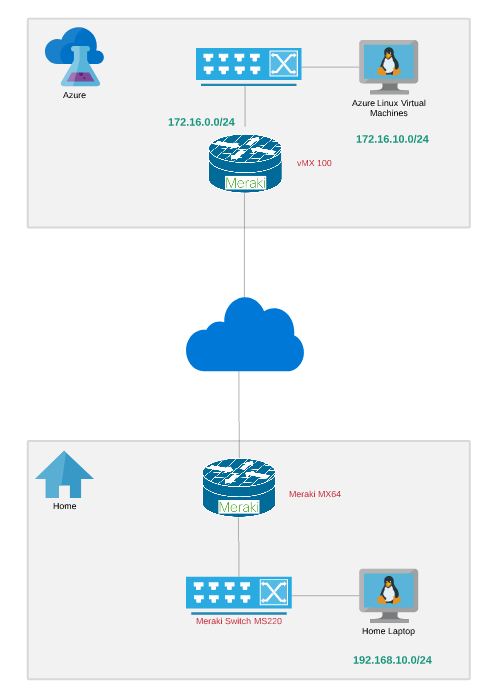

- #Cisco meraki vpn client setup window how to
- #Cisco meraki vpn client setup window manual
- #Cisco meraki vpn client setup window windows
New-Item -Path $registryPath -Force | Out-Null $Name = "AssumeUDPEncapsulationContextOnSendRule" $registryPath = "HKLM:\SYSTEM\CurrentControlSet\Services\PolicyAgent"

#Cisco meraki vpn client setup window how to
Their documentation only explains how to configure the connection manually, so I decided to. Cisco does a great job with their documentation but unfortunately they didn’t do so well with explaining how to configure their VPN connection for medium to large scale companies. # AssumeUDPEncapsulationContextOnSendRule Automate your Meraki Client VPN Connection. Write-host "The connection " $ConnectionNamePrimary " did not already exist"Īdd-VpnConnection -Name "$ConnectionNamePrimary" -ServerAddress "$ServerAddressPrimary" -AllUserConnection -TunnelType L2tp -L2tpPsk "$PresharedKeyPrimary" -IdleDisconnectSecond 14400 -AuthenticationMethod Pap -SplitTunneling -DnsSuffix $DNSSuffix -Force Remove-VpnConnection -Name "$ConnectionNamePrimary" -AllUserConnection -Force -ErrorAction Stop # Remove the connection if it already exists $AreWeConnected = Get-NetIPAddress | Where-object # Check the clients currently IP addresses to make sure we are not already connected to the network issued by Meraki VPN $ClientVPNIPRange = "10.65.0.*" # A wildcard * match for client IP The MX will then forward the traffic towards the destination. Client VPN creates a tunnel from the client and forwards all VPN traffic through that tunnel to the MX. $DNSSuffix = "internal dns suffix" # for eample The Meraki Client VPN utilizes the native VPN client built into Windows, OS X, and iOS clients to name a few examples. $ConnectionNamePrimary = "Meraki VPN" # The name of the VPN connection that will appear on the client $ServerAddressPrimary = "your mx" # You MX external IP or DNS name Check the check boxes for the modules that you need to install. If your pop-up asks if you are sure you want to run this software, select Run. $PresharedKeyPrimary = "Shared Secret" # Your Client VPN Shared Secret A pop-up window may ask for permissions, in this case, select Yes. Security & SD-WAN => Client VPN => Subnet This is wildcard search, so for example if your Client VPN Subnet was set to 10.65.0.0/24 on Meraki within the script you could use “10.65.0.*” to match any IP addresses starting with 10.65.0. We can’t remove a connection if we are already connected. $ClientVPNIPRange – The script will remove and re-add the connection if it already exists, this variable is used to check if any of the clients current IP addresses match the range issued by the your Meraki Client VPN. Found by running ipcofig /all against Primary Dns Suffix on a domain joined computer. $DNSSuffix – Your internal network DNS suffix i.e. $ConnectionNamePrimary – The connection name that will be clicked on the client when connecting. $ServerAddressPrimary – Your MX appliances external IP address or DNS name found under Security & SD-WAN => Appliance Status => Uplink on Meaki $ServerAddressPrimary – Your Client VPN “Shared secret”, found under Security & SD-WAN => Client VPN on Meraki Add a new user in 'Security Appliance' > 'Client VPN'. Enter and note your 'Client VPN subnet' and 'Secret'. Enable VPN in 'Security Appliance' > 'Client VPN'.

Go to 'Security Appliance' and write down your Public IP address or Host name and 'Local LAN'. Once your appliance is configured you will need to change the five variables at the top of the script You can prepare your Cisco Meraki MX84 to VPN connection in a few simple steps: Connect to your Merakis web interface.
#Cisco meraki vpn client setup window manual
Steps on how to configure Client VPN on the MX appliance and manual client deployment can be found within the Meraki documentation There is really no documentation at all.Below you will find an PowerShell script I have previous used to deploy a Meraki Client L2TP VPN connection.
#Cisco meraki vpn client setup window windows
but I can't find anything that will let me connect my Meraki over to a Windows RRAS server and route from there.Īny concise help would be appreciated. However, I do not know how to set up my Windows Server with RRAS to accept those IPSec connections from the Meraki, have it appear in RRAS, and then be able to route to the rest of my remote network.Ĭan someone point me the way? The Meraki documentation made it look easy to connect to a Cisco router. So, instead of the Client VPN option on the Meraki, I really want to get the Site-to-Site VPN option to work. I really cannot get anything to work from the Meraki side back to the RRAS side. This would work if I only needed one way communication into the network. But that only gets me into the Meraki side. So far, I can add a persistant network connection in my RRAS to connect to my Meraki using the Client VPN settings on the meraki. Trying to experiment with implementing a site-to-site VPN connection from my Meraki network (Network A) to a Windows Server 2008 RRAS Server in another location (Network B).


 0 kommentar(er)
0 kommentar(er)
